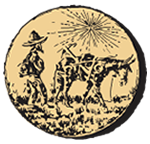Mining and Minerals Education Foundation |
Sir Alfred Chester Beatty (1875-1968)
American Mining Magnate
2025 Inductee from Mining’s Past
 Sir Alfred Chester Beatty, known as the “King of Copper,” had a major role in developing large copper deposits worldwide, especially porphyry copper deposits in Utah, Nevada, Arizona, and New Mexico and sediment-hosted copper deposits in the Copper Belt of current day Zambia and the Democratic Republic of Congo.
Sir Alfred Chester Beatty, known as the “King of Copper,” had a major role in developing large copper deposits worldwide, especially porphyry copper deposits in Utah, Nevada, Arizona, and New Mexico and sediment-hosted copper deposits in the Copper Belt of current day Zambia and the Democratic Republic of Congo.
Beatty was born into a middle-class family on the site of what is now the Rockefeller Center in Manhattan, New York. After graduating from Columbia School of Mines in 1898 with his Master of Engineering degree and his Doctor of Science degree, he bought a one-way ticket to Denver, Colorado. His first job in the mines earned him $2 per day as a "mucker", clearing away rocks and soil from mine tunnels.
Beatty joined the management team of the Guggenheim Exploration Company in 1903. He went on to serve as a Director of Nevada Consolidated Copper Co., Ray Consolidated Copper Co., and Chino Copper Co. In 1908, when he left the Guggenheims, he was regarded as one of the country's leading mining engineers. He then set up an office on Broadway, Manhattan as an independent mining consultant.
He moved to England and founded the London-based mining company, Selection Trust, in 1914. World War I delayed the company's expansion, but during the 1920s the business expanded to acquire interest in the USSR, present-day Ghana and the Colony and Protectorate of Sierra Leone. He made a fortune in present-day Zambia and present-day Democratic Republic of the Congo through the Rhodesian Selection Trust Ltd., and his development of the Bwana M’Kubwa and Mufulira mines.
He became a naturalized British subject in 1933. Beatty had supported the war effort, contributing large volumes of raw materials to the Allies. He received a belated knighthood by Elizabeth II in the 1954 Birthday Honours for his contribution to the wartime effort.
Beatty was a noted collector. He moved to Ireland in the early 1950s and was made a Freeman of Dublin in 1954. In 1957, he was the first person to be granted honorary citizenship of Ireland. He continued to collect in the 1950s and 1960s, acquiring important Ethiopian manuscripts and Japanese printed material during that period.
Print Version Previous Archive Next
